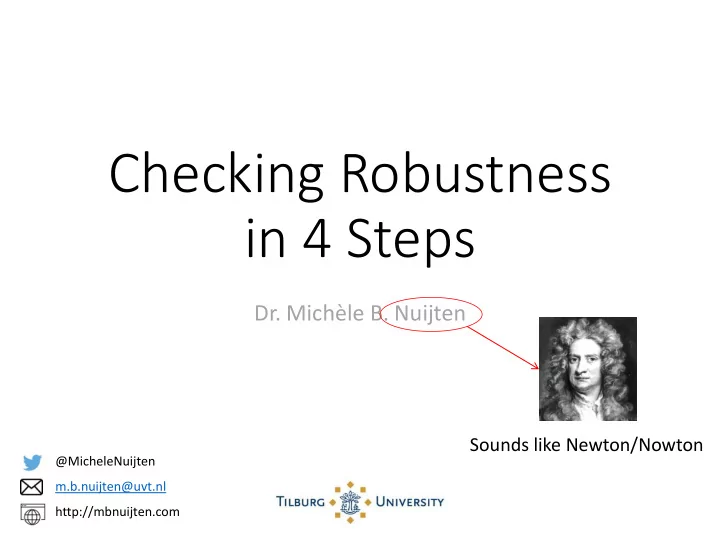

Checking Robustness in 4 Steps Dr. Michèle B. Nuijten Sounds like Newton/Nowton @MicheleNuijten m.b.nuijten@uvt.nl http://mbnuijten.com
My background. @MicheleNuijten 2
Today. Assessing and improving robustness of psychological science in 4 steps (while using minimal resources). @MicheleNuijten 3
Robustness. Studying the Effect of X on Y We found an effect Robustness ≈ “ Can I trust this result ?” of X on Y. @MicheleNuijten 4
Assessing robustness through replication? Studying the Cons: Effect of X on Y Studying the We found an effect Effect of X on Y: of X on Y. A Replication We did not find an effect of X on Y. @MicheleNuijten 5
Focus on reproducibility first. Replicability A study is successfully replicated if the same/a similar result is found in a new sample. Reproducibility A study is successfully reproduced if independent reanalysis of the original data, using the same analytic approach, leads to the same results. @MicheleNuijten 6
Reproducibility is a prerequisite for replicability. Original data Studying the Effect of X on Y p > .05?? @MicheleNuijten 7
Reproducibility is a prerequisite for replication. • If a result is not reproducible, it Studying the has no clear bearing on theory or Effect of X on Y practice • An irreproducible number is effectively meaningless You don’t need replication to find out whether this finding is robust. It’s not. @MicheleNuijten 8
Today. Assessing and improving robustness of psychological science in 4 steps (while using minimal resources). @MicheleNuijten 9
The 4-Step Robustness Check 1. Check the internal consistency of the statistical results 2. Reanalyze the data using the original analytical strategy 3. Check if the result is robust to alternative analytical choices 4. Perform a replication study in a new sample @MicheleNuijten 10
Today. Assessing and improving robustness of psychological science in 4 steps (while using minimal resources). @MicheleNuijten 11
1. Check the internal consistency of the statistical results. Studying the Effect of X on Y = Statistical sanity check @MicheleNuijten 12
1. Check the internal consistency of the statistical results. p = .8 .86 @MicheleNuijten 13
1. Check the internal consistency of the statistical results. 16,000+ Psychology papers Nuijten et al. (2016) R package Epskamp & Nuijten, 2014 @MicheleNuijten 14
1. Check the internal consistency of the statistical results. R package Epskamp & Nuijten, 2014 @MicheleNuijten 15
2. Reanalyze the data using the original analytical strategy. Original data Studying the Effect of X on Y p = ? @MicheleNuijten 16
2. Reanalyze the data using the original analytical strategy. Data in psychology often Original data not available Alsheikh-Ali et al. (2011); VanPaemel et al. (2015); Nuijten et al. (2017); Hardwicke et al. (2019) Unusable data or analytical procedure unclear Kidwell et al. (2016); Hardwicke et al. (2019) Results not reproducible p > .05?? Ebrahim et al. (2014); Hardwicke et al. (2018); Maassen et al. (forthcoming) @MicheleNuijten 17
3. Check if the result is robust to alternative analytical choices. Test two-tailed instead p > .05 of one-tailed Remove one seemingly p > .05 arbitrary covariate Original data p < .05 Include the outlier that p > .05 was removed Exclude the last p > .05 observation @MicheleNuijten 18
3. Check if the result is robust to alternative analytical choices. @MicheleNuijten 19
4. Perform a replication study in a new sample. 1. Check the internal consistency of the statistical results 2. Reanalyze the data using the original analytical strategy 3. Check if the result is robust to alternative analytical choices 4. Perform a replication study in a new sample Failed replication more likely to have bearing on the effect @MicheleNuijten 20
Today. Assessing and improving robustness of psychological science in 4 steps (while using minimal resources). @MicheleNuijten 21
Improving robustness. 1. Check the internal consistency of your own statistical results • Use and related tools for self-checks / in the peer review process http://statcheck.io @MicheleNuijten 22
Improving robustness. 2. Facilitate reanalyis of the data - • Share data • Share well-documented data • Share analysis scripts EFFORT • “ In-house ” code review (co-authors = co-pilots) • Code review during peer review • Fully reproducible dynamic manuscripts (R Markdown, Code Ocean, Docker, etc.) + @MicheleNuijten 23
Improving robustness. 3. Report whether your result is robust to alternative analytical choices • 21-word solution Simmons et al. (2011) @MicheleNuijten 24
Improving robustness. 3. Check and report whether your result is robust to alternative analytical choices • Journals could require sensitivity analyses • Multiverse analysis Steegen et al. (2016) @MicheleNuijten 25
Improving robustness. 4. Facilitate replication in a new sample Write detailed methods sections/appendices and share materials & protocols! @MicheleNuijten 26
Discussion. Assessing and improving robustness of psychological science in 4 steps (while using minimal resources). • If you ’ re interested in the robustness of a specific study • Context matters: an inconsistency in the 3rd decimal doesn ’ t automatically mean you shouldn ’ t replicate • Regardless of the logic of the 4-step robustness check: All published research should always be reproducible! @MicheleNuijten 27
Thank you! A 4-step robustness check to assess and improve psychological science. 1. Check the internal consistency of the statistical results 2. Reanalyze the data using the original analytical strategy 3. Check if the result is robust to alternative analytical choices 4. Perform a replication study in a new sample @MicheleNuijten 28
Recommend
More recommend